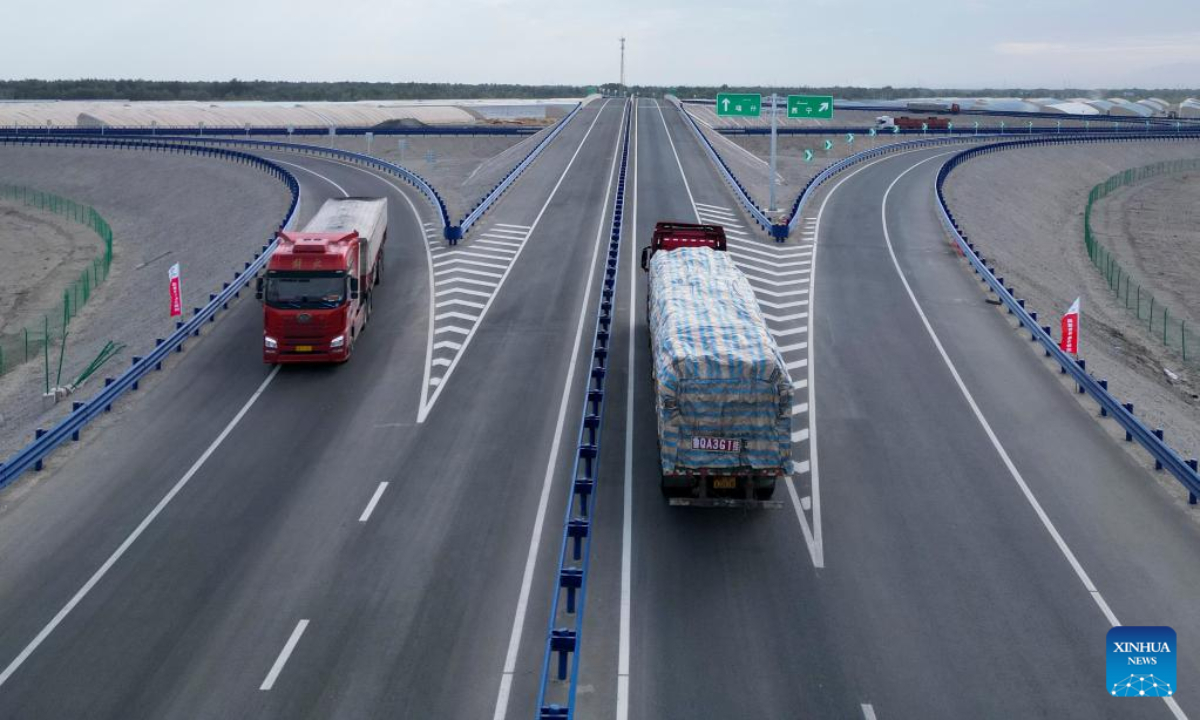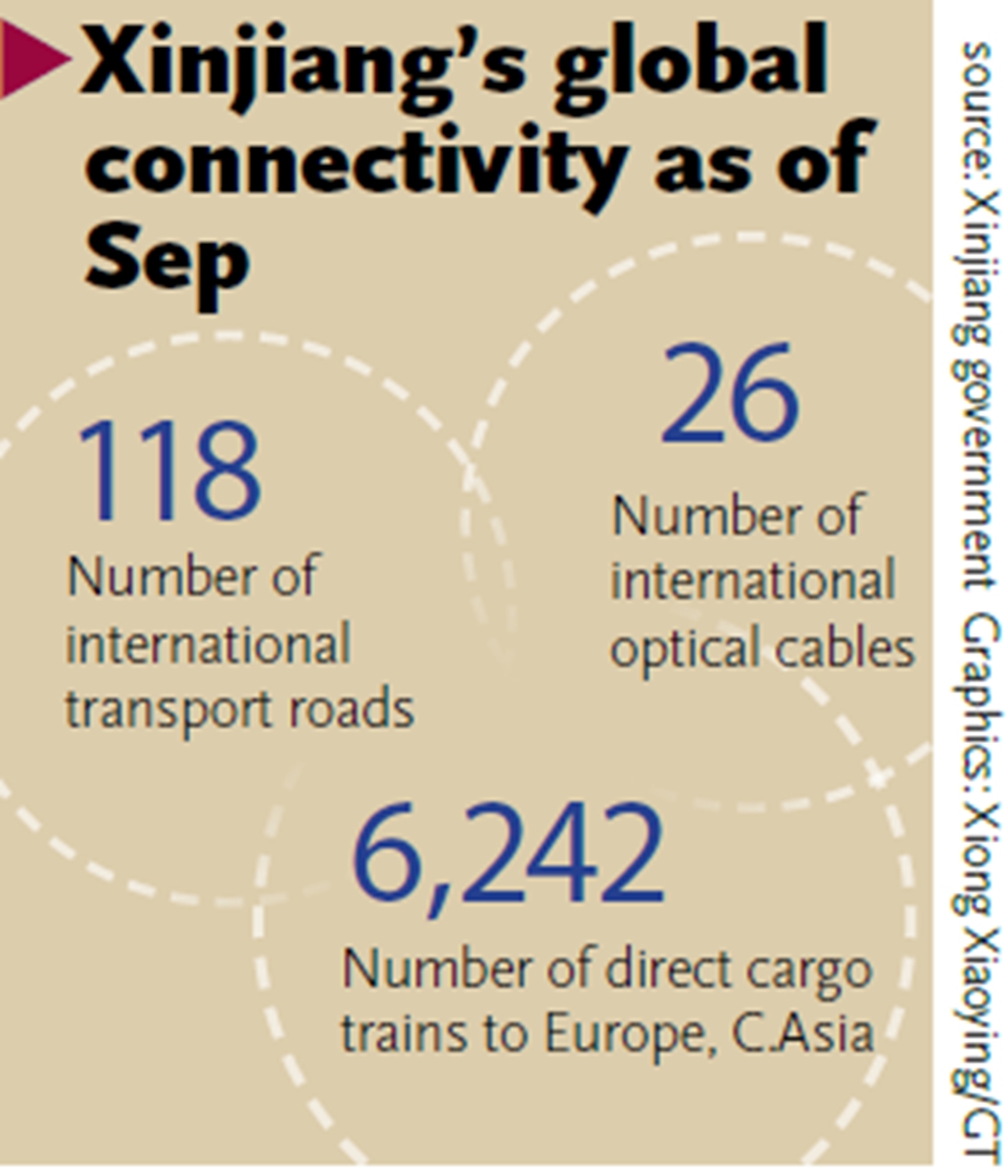
Aerial photo taken on Aug. 30, 2022 shows vehicles streaming through a tollgate of the Yetimbulak-Ruoqiang expressway in northwest China's Xinjiang Uygur Autonomous Region. Photo:Xinhua

Photo:GT
A potential free trade zone (FTZ) encompassing Shanghai Cooperation Organisation (SCO) members, with Northwest China's Xinjiang region as a hub and main driver, is worthy of serious consideration, a leading Chinese scholar proposed at a parallel forum of the 7th China-Eurasia Expo on Tuesday.
Due to competing geopolitical interests by global powers, creating an FTZ for SCO member countries will be a daunting task, but some of the underlying fundamentals are starting to ripen, Fan Gang, president of the China Development Institute, said at the 2022 Summit Forum on the Silk Road Economic Belt's Core Region Development.
Fan noted that while the US and some of its allies are trying to contain China's growth, China is bolstering ties with neighboring countries and emerging markets, forging a closer partnership with countries on the Eurasian landmass. It will be a step of key significance in the development of the northwestern China region and it's also aligned with China's national strategic interests, he said.
While the SCO focuses on security issues, economic and trade cooperation among member states and other partners have also increasingly become an important aspect, given the global economic challenges.
China has also been actively promoting multilateral free trade. China is already a signatory of the Regional Comprehensive Economic Partnership, the world's largest free trade pact, accounting for roughly 30 percent of the world's population, GDP and trade.
Analysts pointed out that the economic potential of SCO member countries is significant, as they accounted for about one-quarter of global GDP in 2021 and a similar percentage in global crude output.
China set up a SCO Demonstration Area in Qingdao, East China's Shandong Province in 2018. Since then, the area has launched 17 international freight train services running to Tajikistan and Kyrgyzstan as well as Hamburg, Germany, serving as link to the sea for landlocked Central Asian countries and a vital regional logistics hub, according to a people.com.cn report on Tuesday.
These trains can channel goods to 51 cities in 22 countries and regions, including SCO members and other countries along the Belt and Road Initiative (BRI).
It is time for such mechanisms to be expanded, according to Fan. "Countries in the region enjoy a high level of political trust and they all tend to regard economic development as the top priority. Besides, all regional countries with the exception of Uzbekistan are WTO members, offering a basis for trade facilitation," he said.
In addition, infrastructure connectivity between Xinjiang and neighboring countries has greatly improved over the past decade, Fan added.
Xinjiang has opened up 118 international road traffic routes, which accounted for one-third of the national total since 2012. A second railway linking Kazakhstan was completed during the period and a total of 26 international cable lines were built. A multidimensional connectivity network has been basically completed, according to local news portal ts.cn.
China-Europe freight train services in and out of the Khorgos land port have reached 5,013 train journeys this year, topping 5,000 and reaching the record 27 days faster than 2021, the China State Railway Group Co said in a statement sent to the Global Times on Tuesday.
Year-to-date, the rail port of Khorgos has added 15 train routes to expand the total number of logistics routes to more than 70. Via a dialogue mechanism with Kazakhstan's railway authorities to tackle technical issues, daily train dispatches at the port have remained at 18 or above.
David Li Daokui, a professor with the School of Economics and Management at Tsinghua University, said building Xinjiang as a core has broader meaning under the current global economic landscape.
Many BRI markets are expected to maintain a reasonable growth rate while many of the world's traditional economic drivers such as the US and the EU are set to slow down, Li said.
In the coming five years, the US will be lucky to maintain a 2-percent annual growth rate, while Germany and France are expected to record 1 percent, Li said.
Li said Xinjiang should grasp the global transition toward clean energy by becoming a production center for wind and solar equipment, and building itself into an international trade center in Central Asia covering warehousing, exhibitions production, and turn itself into a center of talent training in the region.
The building of clean energy generation hardware as well as grid networks will entail investment of some 700 billion yuan ($99.8 billion) by 2030, when 70 percent of electricity is expected to come from wind and solar, Li said, citing his preliminary estimates. That amounts to some 0.7 percent of China's GDP in 2021.
Experts at the forum said in the new era, boosting regional economic and trade cooperation should not be a solo performance by Xinjiang alone, but a chorus jointly performed by neighboring provinces and surrounding countries.





